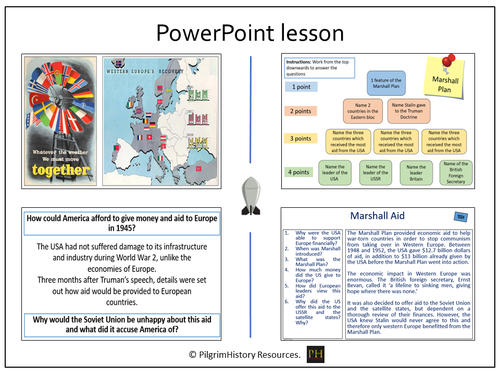



Superpower Relations and the Cold War, 1941-91
This lesson focuses on the financial aid given to Western Europe as part of the Marshall Plan.
Students have to evaluate how significant it was in relation to the Truman Doctrine and how Stalin reacted this ‘dollar imperialism’.
There are differentiated questions which explore why this aid was also offered to Eastern bloc countries, how America was able to offer such huge sums and who received a majority of the aid. There is some text to therefore analyse and use to make inferences.
The plenary asks students a series of questions which recap the lesson and consolidate their learning from previous ones.
There is some GCSE exam question practice to complete, with tips on how to answer the consequences question, with a model answer given if required.
The lesson is enquiry based with a key question using a lightbulb posed at the start of the lesson and revisited throughout this and subsequent lessons to show the progress of learning.
The lessons in this bundle are therefore linked together to build up a picture of how diplomacy, propaganda and spying led two Superpowers with opposing political ideologies to create tensions, rivalries and distrust as well as subsequently forming mutual understanding and cooperation over the time period in question.
The resource includes retrieval practice, suggested teaching strategies, differentiated materials and GCSE exam practice.
It also comes in PowerPoint format if there is a wish to adapt and change.
Something went wrong, please try again later.
This resource hasn't been reviewed yet
To ensure quality for our reviews, only customers who have purchased this resource can review it
Report this resourceto let us know if it violates our terms and conditions.
Our customer service team will review your report and will be in touch.